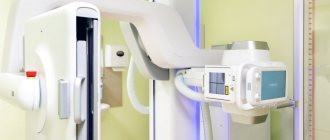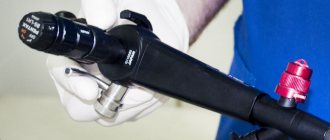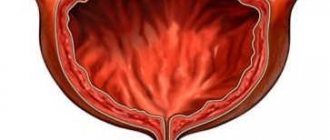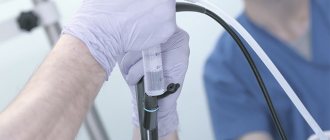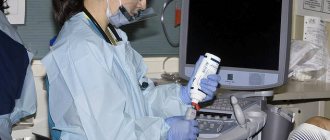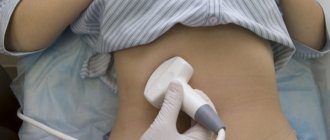Make an appointment with a urologist by phone or by filling out the online form
| Select a clinic | Bladder stones | Cystostomy | Calling a urologist to your home |
Bladder
is an unpaired organ located in the lower abdomen. The organ has a void to fill and is part of the excretory system. It is in it that the accumulation of urea occurs, which leaves the kidneys, after which it is excreted through the urine output channel from the body.
Bladder
- This is a fairly elastic organ; its size can vary as it fills. In an adult, its volume can sometimes reach up to 0.7 liters. The inside of the bladder is covered with a special mucous membrane, which under normal conditions prevents inflammatory processes well.
Structure
As already mentioned, the bladder is a special reservoir for storing urine, which comes there from the kidneys. The latter are connected to the bladder by two ureters. And below it there is a channel that removes urea during the act of urination as the cavity fills.
The bubble itself is oval-shaped (when not empty). The internal structure of the organ is:
- his neck;
- its walls;
- its bottom.
It also has two sphincters. One is located where the urethra begins and is involuntary. The second one is in the middle of the channel. The first sphincter is formed from smooth muscle, and the second from striated muscle. During the act of urination, the sphincters relax and the bladder walls tense.
The bladder itself is the same in men and women, only its location and the organs that are located around it differ. In men, the prostate is located at the bottom of this organ, and the seminal ducts run to the side of it. In the female body, near its back wall, the uterus and vagina are located (this is why during pregnancy you so often want to go pee).
Where to contact
Time plays a key role in the treatment of any oncology.
It is the timing of tumor detection that largely determines the personal prognosis. You should not self-diagnose, prescribe treatment, or be afraid to hear a terrible diagnosis. Today, oncology is curable, and new methods of fighting cancer have emerged. The symptoms described above simply provide information so that you can consult a doctor in a timely manner and not delay the diagnosis. Clinic of Urology named after R. M. Fronshtein of the First Moscow State Medical University named after I.M. Sechenov (State Center for Urology) successfully diagnoses and treats urological pathologies, including oncological ones. Here patients are provided with medical care that meets modern standards. The clinic is equipped with the latest technology; robotic operations are performed here. Most patients of this public clinic return to a full life after treatment. July 28, 2020
Hakobyan Gagik Nersesovich - urologist, oncologist, MD, doctor of the highest category, professor
All the symptoms of the disease...
Upper urinary system
Kidneys
The kidneys are a paired organ, they are located on both sides of the spine in the retroperitoneal space just above the lumbar region and have the appearance of a large bean and are approximately the size of a fist. The right kidney is located slightly lower than the left due to the position of the liver. In an adult, the average kidney is 10 cm long, 6 cm wide and 3 cm thick, and weighs about 120-200 g. The left one is usually slightly larger than the right kidney.
Each kidney is covered by a fibrous capsule that protects the kidney from injury. All pain sensations are associated with this capsule: the organ itself has no pain receptors. When the capsule is damaged or stretched, pain of varying nature and intensity appears.
Kidney tissue or parenchyma consists of outer (cortical) and inner (medullary) layers.
Blood enters the kidney through the renal artery (a branch of the aorta) and is filtered through the microscopic structural working units of the kidney, the nephrons. Each kidney contains about a million nephrons. Their job is to filter blood and produce urine. Each nephron consists of a ball formed by small blood capillaries (the glomerulus), surrounded by a dome-shaped structure, the glomerular capsule (or Bowman's capsule), and a small tube called the renal tubule. Here, the blood plasma is filtered, which leads to the formation of urine.
The urine storage system consists of small renal calyces, which, merging with each other in 2-3 groups, form a large renal calyx, and these in turn form the renal pelvis. The renal pelvis passes directly into the ureter.
All functions normally performed by two kidneys can be adequately performed by one healthy kidney. Some people are born with only one kidney, while others choose to donate one kidney for transplantation into a person with kidney failure.
Basic kidney function
is to maintain the correct balance of water and minerals (including electrolytes) in the body.
An important function of the kidneys is to regulate fluid balance by excreting excess water in the form of urine while maintaining the required amount of water in the body, which is necessary for life. When the kidneys lose their ability to remove excess water, edema appears.
The kidneys regulate the balance of minerals and substances such as sodium, potassium, calcium, phosphorus, magnesium and bicarbonate and maintain normal blood composition. Changes in sodium levels can affect a person's mental state, while changes in potassium levels can have serious adverse effects and cause problems with the heart and muscle function. Maintaining normal levels of calcium and phosphorus is essential for healthy bones and teeth.
Additional functions of the kidneys include:
- Filtration and removal from the body of food processing waste, medications and harmful substances (toxins).
- Creatinine and urea are two important byproducts of kidney function that can be easily measured in the blood. Their values in blood tests reflect kidney function. When kidney problems occur, creatinine and urea levels increase.
- Regulate Blood Pressure – The kidneys produce various hormones (renin, angiotensin, aldosterone, prostaglandins, etc.) that help regulate the amount of water and salt, the levels of which play a vital role in maintaining blood pressure. Impaired hormone production and salt and water regulation in a patient with, for example, kidney failure can lead to high blood pressure.
- Blood volume regulation
- Regulating blood pH
- Converts vitamin D into its active form, which is necessary for the absorption of calcium from food, growth of bones and teeth, and maintenance of their health. Decreased levels of active vitamin D lead to decreased bone growth rates. Slow growth may be a sign of kidney disease in children.
Erythropoietin
is a hormone produced in the kidneys and plays an important role in the production of red blood cells. With kidney failure, the production of erythropoietin decreases, which in turn leads to a decrease in hemoglobin levels (anemia). This is the reason why the hemoglobin count does not improve in patients with kidney failure despite taking iron supplements and vitamins.
Ureters
These are fibromuscular tubes that drain urine from the renal pelvis to the bladder and are about 25-30 cm long and 6-8 mm wide. They enter the bladder from behind and at an angle, ending in the lumen of the bladder in the form of holes - the mouth of the ureters. The lower ureter is compressed by the bladder wall passively during urine storage and dynamically during voiding. Essentially, it is a valve that prevents vesicoureteral reflux (i.e., stops urine from flowing back into the kidneys). The wall of the ureter is made up of three layers, including a layer of muscle that helps it contract and move urine from the kidney to the bladder. Small portions of urine enter the bladder from the ureters approximately every 10-15 seconds.
Along the length of the ureter there are three physiological narrowings: at the level of the transition of the pelvis to the ureter, the place of intersection with the common iliac vessels and in the thickness of the bladder wall. With urolithiasis, stones can get stuck in places where the ureters are narrowed, causing renal colic.
When to see a doctor
A few isolated cases of urinary incontinence do not require medical attention. But if the problem worsens the quality of life or affects the state of health, you should seek help from a medical institution.
Symptoms that should alert you:
- Constant leakage of urine.
- The sudden emptying of the bladder precedes the trip to the toilet.
- Constant urge to urinate without emptying.
- Frequent urination in small quantities.
- Appearance of blood in the urine.
- The urine became cloudy, opaque, the color and smell changed.
- Pain in the back or bladder area appears.
Many problems arise during menopause and the aging of the body. But if urination is accompanied by pain, a feeling of incomplete emptying and frequent urges, you should check with a doctor.
The bladder, which holds urine for a long time, is more likely than the kidneys or ureter to become the site where tumors develop.
Diseases
Bladder diseases are considered the most common group of reasons why a man seeks medical help. These include congenital anomalies of structure or location, inflammatory processes, infections, innervation disorders and injury to this organ.
Symptoms of bladder diseases
There is a group of main symptoms that are characteristic in certain combinations for bladder pathologies.
Among these signs are:
- Increased frequency, reduction of urination, retention, incontinence or the need for effort for the process, increased frequency of urination at night;
- Feeling of pain in the lower abdomen;
- Pain during urination;
- Changes in the color of urine, the appearance of an unpleasant odor, its cloudiness, the appearance of blood or other impurities.
Methods for diagnosing diseases
Diagnosis of any bladder disease begins with collecting an anamnesis from a specialist. Then standard laboratory tests , including a general blood and urine test. Diagnosis also includes methods of visualizing a hollow organ, often ultrasound, less often X-ray examination with contrast. A medical professional may also prescribe a cystoscopy.
Major diseases
Bladder diseases are diverse, but we can highlight the most common ones and some of their features.
Urolithiasis or urolithiasis
It is characterized by the fact that metabolic processes in the body are disrupted , and stones begin to form in any structure of the urinary system, including in the bladder.
Symptoms include the presence of dull pain in the lower back, which is constant, a persistent feeling of the urge to urinate, intensifying with movements, the appearance of blood in the urine , its cloudiness and the acquisition of an unpleasant odor, general intoxication in the form of fever and chills.
Cystitis
It is an inflammatory process that affects the mucous membrane of the bladder, which causes disruption of its functions. It can occur in acute and chronic form.
In acute cases, there is an increase in urination, including at night, the appearance of a false urge to urinate, the appearance of pain during urine excretion, the appearance of blood impurities and cloudy urine.
There may also be signs of intoxication in the form of fever, general weakness and chills. In the chronic form, the course is most often wavy, blood or mucus periodically appears in the urine in small quantities, pain is mild, and signs of intoxication may be absent.
Leukoplakia
In the case of the bladder, it is a chronic process when the cells lining the walls of the organ are normally replaced by cells of squamous keratinizing epithelium.
The main sign of pathology is chronic dull pain in the pelvic area, pain or burning during urination, and disturbances in this process.
Tumor
A bladder tumor that affects the bladder causes such clinical signs as the appearance of blood in the urine, urinary disturbances in the form of difficulty and the process accompanied by itching or cutting pain, pain in the lower back, lower abdomen, perineum and sacrum.
SRMP
Irritable bladder syndrome is essentially a psychosomatic pathology of the process of urine excretion. The clinical picture will be represented by urinary disorders combined with pain and itching , increased nighttime urge to visit the restroom, a constant feeling of an organ full of urine, and a small amount of evacuated urine.
Hyperactivity
The disease manifests itself in the form of a sudden and irresistible desire to visit the toilet for minor needs, there may be incontinence, increased urination, especially at night.
Neurogenic
A variant of a complex urination disorder associated with disturbances in the functioning of the nervous system. The clinical manifestations and course of the disease are very diverse .
Cold
In the case of this anatomical structure, it begins with general weakness and cutting pain in the area where it is located. Then the process of urine excretion becomes more frequent, but the amount released at a time decreases, down to a few drops. There is also sharp and severe pain in the lumbar and lower abdomen, fever, and a change in urine to a darker shade with a pungent odor.
Endometriosis
quite specific to men , which develops due to the fact that they sometimes retain the rudiments of embryonic tissue that gives rise to the entire genitourinary system, and is also characteristic of the female body.
These cells become the basis for the development of endometriosis, especially often when a man receives estrogen therapy.
Atony
It manifests itself in the form of uncontrolled urination , its spontaneity, but with a purposeful visit to the restroom there may be urine retention or incomplete excretion . Patients note that the stream becomes weak.
exstrophy
It is a malformation of the genitourinary system , when the bladder is not localized intraperitoneally, as it opens from the outside. In this case, there will be no anterior wall of this organ, and the ureters will open to the outside world.
Polyps
They represent an abnormal process of tissue proliferation on the mucous membrane of the bladder . The disease can be completely asymptomatic. But when straining, the polyps can become injured or even tear off, since they are located on a thin stalk, and then an admixture of blood appears in the urine.
Cyst
It manifests itself primarily as dysuria, fever, abdominal pain, general malaise, the appearance of swelling or hyperemia on the abdominal wall below the navel.
Diverticulum
This sac-shaped depression is a developmental anomaly that is formed in utero or acquired with a prolonged increase in intravesical pressure, combined with overstretching of the weakened walls of the organ.
It manifests itself in the form of dysuric disorders, urinary retention, the process of urination becomes two-stage (the first part is normal urine output, the second is from the diverticulum and during straining). Blood or pus may appear in the urine.
Weak bladder
It can be in this state due to infections or pathologies of the prostate in men. The main symptoms will be an increased urge to urinate , especially at night, and urinary incontinence.
Prolapse or cystocele
It manifests itself as a constant feeling of needing to go to the restroom, but when you try to urinate, nothing happens. In turn, urinary incontinence may also occur, especially with abdominal strain and lifting heavy objects. Pain in the lower abdomen also appears, radiating to the lower back.
Cancer
Bladder cancer is a terrible diagnosis for any person ; it proceeds for a long time without any symptoms, and then general weakness and hematuria appear.
Urinary incontinence
This disease in men is often associated with diseases of the bladder sphincter or with increased activity of the muscle layer in the walls of the organ.
The pathological processes of the bladder are quite similar in their symptoms and the result of a number of tests is necessary for a conclusion, so you cannot try to make a diagnosis yourself .
How is blood purified and urine formed?
Healthy kidneys filter about 100 ml of blood every minute, removing waste and extra water to eventually form urine.
There are three main stages of urine formation:
- filtration
- reabsorption
- secretion
In the process of purifying the blood, the kidneys retain all the necessary substances and selectively remove excess fluid and waste from the body.
- per day, the kidneys produce 140-180 liters of primary urine; in 24 hours, all circulating blood is cleansed several times; with age, these processes slow down
- the purification process takes place in small filter units known as nephrons.
- each kidney contains about a million nephrons, and each nephron consists of glomeruli and tubules.
- glomeruli are filters with very small pores, characteristic of selective filtration. Water and small substances are easily filtered through them. But larger red blood cells, white blood cells, platelets, protein, etc. cannot pass through these pores. Therefore, such cells are usually not visible in the urine of healthy people.
- The first stage of urine formation occurs in the glomeruli, where urine is filtered in an amount of 100-125 ml per minute, thus 140-180 liters of primary urine are formed in 24 hours. It contains not only industrial waste and toxic substances, but glucose and other useful substances.
- Each kidney performs the process of reabsorption (reabsorption). Of the fluid entering the tubules, 99% of the fluid is selectively reabsorbed and only the remaining 1% of the fluid is excreted as secondary urine. Thanks to this process, all the necessary substances are reabsorbed in the tubules, while 1-2 liters of fluid containing waste and other harmful substances are excreted from the body in the form of secondary urine.
Thus, the kidneys have filtration and concentration abilities.
Can there be a change in urine volume in a person with healthy kidneys?
YES. The amount of water consumed and atmospheric temperature are the main factors that determine the volume of urine that a normal person excretes.
Depending on the amount of fluid consumed, the amount of urine excreted changes: the more fluid enters the body, the more it is excreted and the less concentrated the urine, its color becomes light, even transparent. If the amount of fluid decreases, then the amount of urine excreted becomes less, it will be more concentrated, and the color will be dark straw.
During the summer months, sweating caused by high ambient temperatures causes urine volume to decrease. During the winter months the opposite is true - low temperatures, lack of sweating and more urine.
In a person with normal water intake, if the urine volume is less than 500 ml or more than 3000 ml, this may indicate that the kidneys need more attention and additional examination.
Make an appointment
Make an appointment with a gynecologist by calling 8(812)952-99-95 or filling out the online form - the administrator will contact you to confirm your appointment
guarantees complete confidentiality
In which foreign countries and clinics is exstrophy treated?
Treatment of exstrophy is carried out by surgeons in different countries. In Europe and the USA, exstrophy is treated by specialists working in multidisciplinary clinics. And this is justified, since to achieve results and teach parents all the nuances of dealing with complex patients, a team of specialists is needed. When treated in small private clinics, for example in Israel, Serbia, etc., operations are performed by one surgeon, reconstruction of the pelvic bones is not performed, and the length of stay in the hospital is sharply reduced. All this saves money, but savings often result in complications and unnecessary operations.
Features of postpartum cystitis
The postpartum period requires close attention and monitoring of the postpartum woman, especially at home. Compliance with the rules of careful hygienic care and a regime of frequent urination will help to avoid possible complications of the period after childbirth and the addition of urinary tract infections.
Postpartum cystitis occurs in the same way as any other, but its treatment is difficult because not all medications can be taken by a nursing woman. In addition, this period is characterized by the presence of damage to the external genitalia, which makes it difficult to urinate and use the usual toilet.
Severe forms of the disease rarely develop, since treatment of cystitis does not cause significant difficulties. But most often we have to deal with a chronic form that is difficult to correct with drugs if the causative agent is a multidrug-resistant microorganism.
Folk recipes
Alternative medicine has gained extensive experience in the treatment of urological infections. The recipes have many positive reviews, which confirms the effectiveness of the methods. But they can only be used in combination with drug treatment.
Good results are obtained by ingesting decoctions of parsley root, chamomile, and tincture of lingonberry leaves. Drinking lingonberry juice has an excellent sanitizing effect. The healing qualities of “bear ears” and cranberries have long been known. You can prepare the following composition and take it three times a day after meals:
- take dry herbs of rosemary, lovage, centaury, and rose hips in equal proportions;
- pour boiling water for 30 minutes;
- boil in a water bath for 20 minutes;
- leave for 30 minutes;
- strain and drink as above.
It is contraindicated to drink alcohol, strong drinks, or smoke during treatment.
How is exstrophy treated and what is the key to success?
Exstrophy is a complex disease with many personal characteristics and problems. Treatment is surgical. To achieve optimal results, you should contact a surgeon who is a specialist in the treatment of exstrophy, who is familiar with all methods and has significant experience in successful reconstructions. The team of doctors must have an experienced orthopedic surgeon to perform pelvic plastic surgery and eliminate the gap between the pubic (pubic) bones. The surgeon and his team must monitor the child for many years, conducting staged surgical treatment and promptly preventing complications, in particular, renal dysfunction. Doctors must be available to contact.
